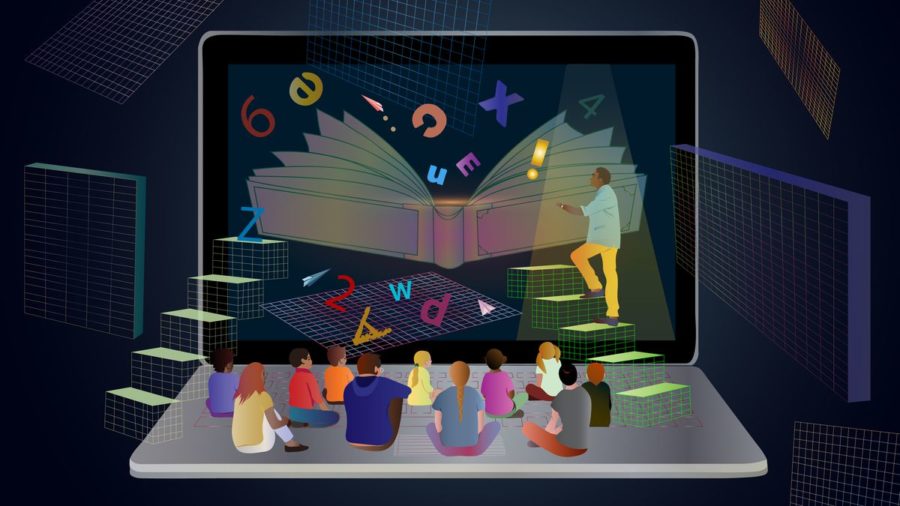The Remains of Remote
Some precedents the school established during remote learning should be carried over into the new normal.
photo courtesy of Efi Chalikopoulou
Some aspects of remote learning would benefit students even when they go back to school full time.
May 19, 2021
I, like most other Americans, cannot wait to put this pandemic behind me. I’m sick of excessive hand sanitizer, quarantines, the general unpredictability of life as we know it, and, perhaps above all else, remote learning.
However, while I’ve found this school year to be mostly dreadful, I can’t deny that online learning has a few advantages that, whenever things do get back to normal, we’d be wise to try to incorporate into our everyday routines.
Since they were teaching online anyway, most of my teachers have recorded their lessons this year. Students who were absent can go watch the lesson they missed, and even students who were present in class can rewatch the class in order to review or clarify any concepts they found confusing.
Before recorded lessons, missing a day of school was a disaster. In most lecture-based courses, the best way to catch up was just to copy down your friend’s notes and get their brief run down of the lesson. If you missed a day where something important or complicated was discussed, it could feel nearly impossible to catch up.
I’m not advocating for students missing more school, but sometimes, it’s unavoidable, and recorded lessons can help make catching up a lot easier.
Not to mention, I’ve barely missed any school days this year, but I have frequently gone back and rewatched video lessons as a way to study, and it has helped immensely. It’s unreasonable to expect anyone, even the most perfect of students, to be focused every second of every single day and retain all the information fed to them. Recorded lessons offer everyone a little grace.
So, if we ever get to a point where classes are not taught over Google Meet or Blackboard Collaborate, it’s still easy enough for a teacher to record their screen and post a video of the lesson later. It’s a practice that should be encouraged, even during post-pandemic school years.
Another aspect of this school year we should consider carrying into the future is Wellness Wednesdays. I’ll be the first to admit that when the school announced that once a week they would run a reverse two-hour delay schedule in order to allow students to catch up on work and promote mental health, I thought it was completely idiotic. What was two hours a week going to do to my overall wellbeing?
It turns out, those two hours do a lot. I now look forward to Wednesdays. They’ve helped me get my work done at a more manageable rate, and I’ve also used the time as a break to spend time with my family or get outside.
I know that Wellness Wednesdays were created during a stressful time of full remote learning, but even without COVID-19, high school students are often overwhelmed by how much is on their plates.
If it is too difficult to manage a reverse two-hour delay schedule during a regular school year, NASH should consider having activity periods. North Allegheny middle schools hold activity periods two to three days a week. They end every class a few minutes early, creating an extra period at the end of the day where students can participate in clubs or catch up on work.
Activity periods would work wonders for high school students struggling with time management. It seems foolish to me that they don’t already exist at NASH. They are a huge success in middle school, and, because students become even busier as they get older, it only seems logical to include them in the high school schedule.
One of the most dramatic changes this year was how testing was conducted. While every teacher took different approaches, many of my teachers leaned towards tests that required more application of concepts and less memorization.
Before remote learning, it often felt like one of the only things I was tested on was my ability to memorize a set of definitions on Quizlet. I spent most of my time memorizing terms, definitions, and lists. This year, however, since cheating was so much easier, most teachers made tests more problem solving or application based.
I loved it. Instead of answering multiple choice questions about a book I read for English class, I got to write a free response about it. Instead of answering questions about theory or steps in a scientific process, I actually just got to do the problem or write out the reaction.
I felt like I wasn’t studying terms nearly as much, but I still understood what I was being taught because I still needed to use it for the test. My education itself felt more holistic, and I actually enjoyed that aspect of it.
Moving forward, tests shouldn’t be designed to test a student’s memorization skills. They should be set up as an indicator of if someone can actually apply what they learned to the real world.
The biggest thing that I’ve noticed, and sincerely appreciated, this year is a general sense of flexibility from my teachers. Most of them have realized this year is just different, and it may require some adjustments.
If the majority of the class is confused about something, most teachers are much more likely to move the test back or go back and re-explain the lesson. If an activity or project takes longer than it has in past years, as long as they see the students are trying their best, more teachers have given extensions or simply used more class time to complete it.
Before this school year, I’ve rarely seen that kind of willingness from teachers to adapt their schedules. Usually, agenda and lesson plans feel set in stone, even if kids are falling behind. So, it’s extremely comforting to know that, if several of my peers and I are struggling with the pacing of something, our teacher is likely to be extremely understanding.
That’s how it always should be. The best teachers are the ones who are receptive to their classes’ needs and want to help them succeed in a way that works for everyone. Flexibility and the willingness to work with students, even after the pandemic, can make a huge difference.
Even though I won’t be around to see it, I do genuinely hope things get back to normal at NASH next year. However, after such a turbulent year, our education system has the opportunity to come back far better than it was before. If the pandemic has taught us anything, it should be that forgiveness, flexibility, and mental health are essential in almost everything we do. It only makes sense they should be prioritized when we go back to our old school routines.













Christopher He • May 19, 2021 at 1:41 pm
agreed